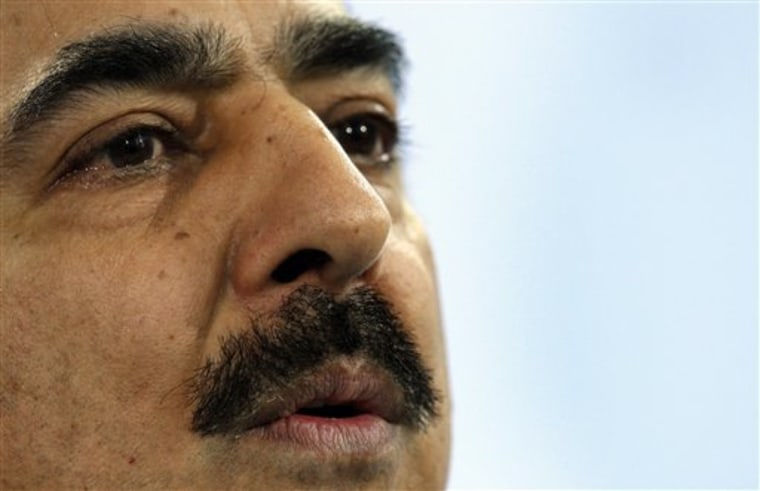Pakistan may launch a new military offensive in a district near the Afghan border where insurgent leaders are believed to have fled to escape a government onslaught against the Taliban in nearby South Waziristan, the prime minister said Saturday.
The suggestion of another anti-Taliban operation illustrates the intractable challenge facing this nuclear-armed U.S. ally: Even as it squeezes one extremist stronghold in its northwest, insurgents simply regroup in other parts of the rugged, loosely governed region.
Prime Minister Yousuf Raza Gilani said the next front may be Orakzai, a district north of South Waziristan in Pakistan's lawless tribal belt. The government has launched a spate of airstrikes there, and the U.N. said Friday that about 40,000 people have already fled.
"The operation in South Waziristan is over. Now there are talks about Orakzai," Gilani told reporters in televised remarks from the eastern city of Lahore.
Gilani later backed down from some of those comments, saying "our military operation in South Waziristan is continuing" and stressing that "there have been lots of successes" in the fight there. He did not give a timeframe for when the South Waziristan operation would end and one in Orakzai might begin.
The military's power
Although Pakistan has had a civilian government for nearly two years after several years of army rule, the military remains a powerful force that is likely to have the last say on where it will send its resources and when it will do so.
Spokesmen for the military did not immediately respond to requests for comment on the prime minister's comments. In the past, military officials have been hesitant to put a timeframe on how long troops will stay in South Waziristan even after major operations end.
The U.S. has long pushed Pakistan to retake spots along the border that have become safe havens for militants. That pressure is likely to intensify now that 30,000 additional U.S. troops are heading to Afghanistan to take on a resurgent Afghan Taliban.
To Washington's chagrin, Islamabad has focused on groups such as the Pakistani Taliban, which threaten its citizens, rather than militants who attack U.S. and NATO forces across the border. Gilani did not indicate a shift in that strategy Saturday.
‘The right move’
Mahmood Shah, a former security chief for Pakistan's tribal regions who has deep contacts in the military, said Pakistan has succeeded in South Waziristan in that it has destroyed much of the Pakistani Taliban's physical infrastructure, but it could not ignore Orakzai if it wanted to eliminate the insurgent leadership.
"The Pakistani Taliban train suicide bombers in Orakzai," he added. "This is the right decision; this is the right move."
Pakistan's army launched its ground offensive in South Waziristan in mid-October, saying it was determined to eliminate its top internal enemy in its most forbidding stronghold. The army said it sent some 30,000 troops to take on about 10,000 militants, including many foreign fighters.
The operation has prompted a slew of retaliatory bombings nationwide that have killed more than 500 people. The attacks have continued even as battlefield activities have slowed down.
On Wednesday, the army reported it had killed 589 militants so far, losing 79 soldiers. But none of the top Pakistani Taliban leaders are known to have been captured or killed in the onslaught, and many are believed to have fled to North Waziristan and Orakzai. The latter has been the home base for Pakistani Taliban chief Hakimullah Mehsud.
Access to the tribal regions is severely restricted, making independent verification of such details nearly impossible. The military's near daily accounts, however, describe fewer battles, less militant killings, and more routine clearance and holding operations.
In recent weeks, the military has occasionally used helicopter gunships to pound militant targets in Orakzai. Such airstrikes could be a prelude to a ground offensive, just as they were in South Waziristan.
Some 40,000 people are estimated to have fled Orakzai in the weeks since the South Waziristan offensive began, the U.N. said in a statement Friday. It said the estimated 2,400 families were going to the nearby districts of Hangu and Kohat. Many are apparently staying with relatives or friends.
Orakzai is a smaller tribal region, covering roughly 600 square miles (1,540 square kilometers). It is sandwiched between the Khyber and Kurram tribal regions and does not directly border Afghanistan. Officials have estimated it has a population of 500,000 people, but recent census figures were unavailable.
Pakistan's tribal belt is largely underdeveloped and its border with Afghanistan is porous. The areas have long had a semiautonomous legal status, meaning the federal government has little influence. Some areas are believed to have become virtual Taliban mini-states.
Over the past year and a half, the Pakistani army also has launched major offensives in the Bajur tribal region and the Swat Valley, while carrying out smaller in operations in Khyber.
One possible immediate challenge the military might face in Orakzai is the cooling weather. With relatively few decent roads, snow could prove a barrier to troops on the move.
Pakistan reached peace agreements with some militant groups in the tribal regions who do not generally attack the Pakistani state so that it could pursue its army offensive in South Waziristan without outside interference.
At least one of those groups, led by Hafiz Gul Bahadur, is based in North Waziristan. That region also is home to many members of the Haqqani network, a group that operates on both sides of the border and is considered a major threat to the U.S.
In hurried remarks Saturday, Pakistani Interior Minister Rehman Malik mentioned North Waziristan as another potential front, though military officials have been loathe to say whether they would want to extend the fight there.
"The government will take action whether it is (South) Waziristan or North Waziristan," Malik said. "Anywhere in the country wherever we see their activities, we will strike."
